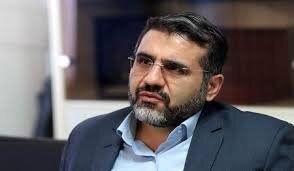
Mohammad-Mehdi Esmaeili, minister of culture and Islamic guidance.
“The individual and social identity of each of us depends on the Persian language.”
While the Persian language and its long literary history are central to shaping Iranian nationalism, Iran is linguistically diverse.[i] As recently as a decade ago, Iranian demographic data suggested only half the country spoke Persian as its primary language. Because the Middle East interlinks ethnicity and language, this also highlights Iran’s ethnic diversity. Persian might be the dominant language in major cities like Tehran, Mashhad, Isfahan, or Shiraz, but other languages predominate in cities on Iran’s geographic periphery: Azerbaijani in Tabriz, Arabic in Ahvaz, Kurdish in Sanandaj, and Baluchi in Zahedan. These same peripheral regions are also among Iran’s most restive.
Against this backdrop, the speech by Iran’s Minister of Islamic Guidance and Culture, Mohammad-Mehdi Esmaeili, on the National Day of Persian Poetry and Language is of note. As the excerpts here translated from the ministry’s website show, Esmaeili promoted the Persian language in nationalistic tones when he said: “Persian language is an important factor in the national unity of Iranians and the common heritage of all Persian speakers.”
Looming in the background to his remarks, but unmentioned by Esmaeili himself, are both Iran’s history of separatism and the tendency of local protestors to chant anti-regime slogans in their local languages. Not only do the roots of Iranian nationhood predate the 19th and 20th century organization of states around ethnicity but also, except for more organic Kurdish nationalism, many of the most famous Iranian separatist movements had foreign sponsorship. That said, the growing tendency of non-Persian Iranians to rally around their ethnic identity, if only to organize against the regime, highlights a growing sense of unease within Iran.
Source:
“Peyam-e Vazir-e Farhang va Erhad-e Islami beh Ayin-e Bazargdasht Roz-e Melli Sha’ar va Adab-e Farsi (The message of the Minister of Culture and Islamic Guidance to the commemoration ceremony of the National Day of Persian Poetry and Literature),” Minister of Culture and Islamic Guidance, 19 September 2022. https://dashti.farhang.gov.ir/fa/news/656734
Persian language is an important factor in the national unity of Iranians and the common heritage of all Persian speakers. The history of this ancient country is filled with advice, doctrines and witticisms embedded in the institution of this proud language that over the years have made the lovers of culture and wisdom sweet and pleasant. Therefore, preserving, strengthening, and expanding this civilization-creating language is an essential and valuable duty to protect the independence and dignity of our land and nation. The individual and social identity of each of us depends on the Persian language, which, like a prism, forms the cultural basis of all Iranians and must be preserved and pursued in advance of this long-held treasure away from any narrow-mindedness and archaeological, ethnic and racial perspective.
Notes:
[i] Despite its efforts after the 1979 Islamic Revolution, Iran was never able to entirely subordinate ethnic and historical pride to the ayatollahs’ religious identity. Iranians continued to celebrate the Persian New Year, a holiday with roots in the pre-Islamic era. They continued to read and memorize the Shahnameh, a national epic that celebrates Persian kings dating to the dawn of time, and promoting Persepolis, the ceremonial capital of the ancient Persian Empire.
Image Information:
Image: Mohammad-Mehdi Esmaeili, minister of culture and Islamic guidance
Source: Donya-e-Eqtesad, https://static4.donya-e-eqtesad.com/thumbnail/E2NKNyIBifNX/QHn8O9nsSzT8qCU7RegsN6Pbb5v74eEtbKeSOh05Rab3-SRYPP1-Ekt7TZyzEhnm/pRNdqkr1kRaj.jpg
Attribution: Public Domain
